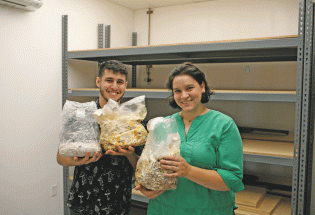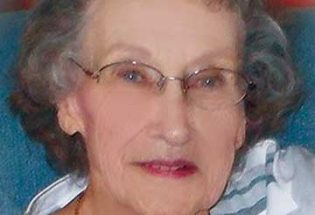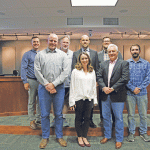Down the drain: The story of a flush, Part 1

Photo by Terry Georgia
Michael Murphy, of Ramey Environmental Compliance, Inc., and leader of Berthoud’s Wastewater Treatment Plant’s team, checks the plant’s aeration basins, part of the process that cleans Berthoud’s wastewater.
By Terry Georgia
The Surveyor
Toilets. Showers. Utility sinks. Garbage disposals. What goes down must come up, somewhere.
If you’re connected to Berthoud’s town water system, everything you send down a drain flows, mostly by the force of gravity, to Berthoud’s two wastewater treatment plants. The main plant is located southeast of town and the other, a sub-station, is east of I-25. There, through a fascinating series of biological wonders, the wastewater is treated and released into the Little Thompson River, cleaner than the water already flowing there.
Arguably one of the most important jobs in any town, wastewater treatment is essential to conserving and preserving one of our most precious natural resources, water. The Berthoud plant processes about 1.2 million gallons of wastewater each day; less is processed in the winter, and more in the summer when rain and runoff have the potential to enter the sewer collection system. The system’s capacity was recently increased to be able to handle three million gallons per day in anticipation of continued community growth.
Ken Matthews, Berthoud’s Director of Water Utilities, leads two teams; one treats wastewater and the other ensures the town’s drinking water is safe. The two systems are not currently tied together. In the future, as water resources become scarce and demand increases, turning treated wastewater into drinkable water within a single system may become a necessity, and is already happening in a few communities, but Berthoud’s wastewater is currently treated and sent downstream.
The Berthoud Wastewater Treatment Plant is currently run on a day-to-day basis by contractor Ramey Environmental Compliance, Inc., which specializes in the management and operations of water and wastewater treatment. They are based in Firestone and operate 32 wastewater facilities and more than 40 water treatment facilities in Colorado.
Ramey’s team in Berthoud is headed up by Michael C. Murphy. On a recent tour of the plant, Murphy explained the process Berthoud uses to turn wastewater into clean water, a process that goes on 24 hours a day. Microscopic organisms that the team fondly refers to as “bugs” break down biological impurities in the wastewater, removing the nitrogen and ammonia and converting them into nitrate ions. The organisms consume oxygen as they work so, Murphy says, “We have to aerate the tanks with oxygen to make the bugs happy.”
The entire process is both simple in its concept and complex in its detail. Roughly, it works like this:
Step 1. The Headworks
Murphy begins his tour by emphasizing that 99% of what comes into the plant is already water, the rest is bio and solid waste. The treatment begins by separating large debris and solids from the incoming water. Paper towels, wipes and other materials that don’t break down are screened out in the Headworks building. A large augur-type device pulls the solids up and out of the water and onto the next building. The water continues to flow through the Grit Chamber, which filters out smaller bits of matter. The solid matter and additional grit are deposited into a large dumpster and hauled to a landfill.
Step 2. The Pump and Lift Station
The entire wastewater system in Berthoud relies primarily on gravity to move water through sewer lines flowing toward the wastewater treatment plants. There are four lift stations strategically located in lower-lying areas to help keep the wastewater moving. The main pump and lift station are located at the wastewater treatment plant. Once the wastewater is cleared of most solids, four large pumps push over a million gallons of water through each day.
The pump room, which sits below ground level, is designed to keep wastewater flowing at all times. In the event that the building is ever flooded, the pumps would continue to run, keeping Berthoud’s toilets “flushable” even if the system is submerged.
Step 3. The Splitter
The wastewater flows from the pump station to a low, concrete bunker called a splitter, where the flow is divided between two underground pipes and moved forward into two massive concrete vats.
Step 4. The Aeration Basins
The aeration basins are the real heart of the wastewater treatment process, where the “bugs” do their best bio-work. Two large concrete vats are filled with brown wastewater, bubbling with pumped-in oxygen and churning with trillions of microorganisms eating up any bio-matter still suspended in the water.
For those who are microbiology buffs, the microorganisms used in Berthoud include amoeboids, flagellates, free-swimming ciliates, stalked ciliates and rotifers. They are hard-working bugs.
In nature, soil acts as a natural water filter. The microscopic organisms in soil “eat” impurities in water as it filters through the ground. The bugs added to Berthoud’s aeration basins are the same organisms that work in the soil. Murphy says the aeration basins replicate the features of a swamp, where this filtering process occurs naturally.
The bugs’ workday in the aeration basins is essentially one very long lunch break. They spend their days ingesting bio-matter. They also begin the process of flocculation where they produce a sticky substance that makes them clump together.
The bugs are carefully monitored by the plant staff throughout the process to ensure they remain healthy and in sufficient supply to clean the water. The bug balance is tricky and, if not watched closely, can turn into a microscopic bug version of a zombie apocalypse.
Tune in next week to find out how Berthoud’s dedicated wastewater scientists keep the bug apocalypse at bay.
- June, 01 2023

Farmer’s Market now on Thursday even...
By Terry Georgia The Surveyor There are changes afoot as Berthoud’s popular farmer’s market updates...
- September, 07 2017

- December, 20 2019

Obituary – Ralph H. Yannutz
Ralph H. Yannutz November 6, 1930 - December 11, 2019 Ralph H. Yannutz, 89, of...
- August, 03 2023

Ambrosia Harvest starts sprouting mus...
Photo by Will CorneliusIsaiah Chavez and Sara Del Cuore with their...
- July, 15 2015

Norma Jeanne Edmisten: Dec. 8, 1925 &...
Norma Jeanne Edmisten, 89, died peacefully on July 8, 2015, at home in Berthoud, Colo.,...
- June, 01 2017

BHS sports 2016-17 year in review
By Dan Karpiel The Surveyor Jessa Megenhardt —Surveyor female athlete of...

Unified basketball comes to Turner Middle School
Community News

Mike Grace says goodbye as Brett Wing joins town board
Community News
POLICEBLOTTER
Community News
Northern Water sets C-BT quota at 70% for 2024
Community News

Emotions run high during Revere Property hearing
Community News
Snowpack at 119% above normal
Community News

Karspeck to serve third term as Berthoud mayor
Community News
COMMUNITY CALENDAR:
Community Calendar – add an event
Homestead Fine Art Gallery First Fridays OPEN HOUSE
03 May 4:00 PM - 7:00 PM
Homestead Fine Art Gallery First Fridays OPEN HOUSE
07 Jun 4:00 PM - 7:00 PM
Homestead Fine Art Gallery First Fridays OPEN HOUSE
05 Jul 4:00 PM - 7:00 PM
Homestead Fine Art Gallery First Fridays OPEN HOUSE
02 Aug 4:00 PM - 7:00 PM
Homestead Fine Art Gallery First Fridays OPEN HOUSE
06 Sep 4:00 PM - 7:00 PM
Homestead Fine Art Gallery First Fridays OPEN HOUSE
04 Oct 4:00 PM - 7:00 PM




